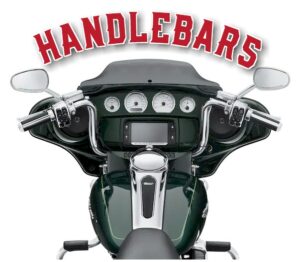 First things first – before you rush off and buy your shiny new handlebars, you need to know the diameter of the existing handlebars. Most Sports bikes have 22mm (7/8”) bars and Harley-Davidsons/Japanese Cruisers have 25mm (1”) handlebars. If you choose the wrong size, your grips, risers etc won’t fit and it will be an expensive business to replace all of these.
First things first – before you rush off and buy your shiny new handlebars, you need to know the diameter of the existing handlebars. Most Sports bikes have 22mm (7/8”) bars and Harley-Davidsons/Japanese Cruisers have 25mm (1”) handlebars. If you choose the wrong size, your grips, risers etc won’t fit and it will be an expensive business to replace all of these.
If you currently have 1” handlebars and would like to fit Fat 1.25” (32mm) bars without changing your existing grips and risers, this is usually possible if the bars are sleeved down to 1” at the grips and centre section. If you want 1.5” handlebars like the ones by Tolemar you will need new 1.5” riser clamps, but these bars are sleeved down to 1” at the grips. If you don’t know the diameter of your bars, measure the circumference (all the way round the outside) with a soft tape measure in millimetres. Around 79mm – you have 25mm bars, around 69mm – you have 22mm bars.
Next take a note of the measurements of your existing bars (so you can compare new bars to what you’ve already got). Here’s what to measure: Overall width – from tip to tip (best done with grips removed). Height (rise) – place a flat piece of wood or similar, across top of bars then measure down to bottom of bars. Centre width – measure centre section between left and right side of handlebars that is flat and straight. Pullback – place flat piece of wood or similar, from one end of the bars to the other. Measure from the centre of the risers back to the centre of the piece of wood. Photos below should help explain this (courtesy of Wild One Chubbys).One quick word of warning: not every manufacturer measures handlebars in the same way, so the same dimensions on paper may not always produce the same bars.
Sit on your motorcycle as you would if you were riding the bike. Your back should be comfortable and your feet should reach the pedals. If you can, get somebody else to help support the bike while you find the riding position that’s comfortable for you. Try raising/lowering your arms and putting them wider/closer together, until you find the place that’s right for you.
Get your mate to measure the height, width and pullback in the position that felt most comfortable. Now seek out handlebars that most closely match these measurements.
To help you out, here’s a summary of common styles of handlebars:
Drag Style – completely level, these bars have no rise and come in a range of widths with limited pullback. Tend to result in a lower, more aerodynamic riding position.
Flyer or Beach Bars – wide and low with more pullback than Drag Style bars, allowing a more comfortable upright riding position.
Cruiser or Dresser – as the name implies, these are made for comfort on long rides with a high degree of pullback.
Ape Hangers – extend high over the level of the bike, this places the arms in a higher and wider position than with other bars. You can choose fully extended Apes up to 20” high, but most folk opt for 16” or lower mini ape hangers which don’t drain the blood from your fingers.
T-Bars – unlike other handlebars which have a separate riser clamp securing the bars, T-bars fit directly into the triple trees (yokes). Usually model specific.
One final thing to bear in mind is if you dramatically change the width or height of your handlebars is you may need to buy longer control cables (throttle, idle, clutch and brake) which will usually cost more than the handlebars themselves.

